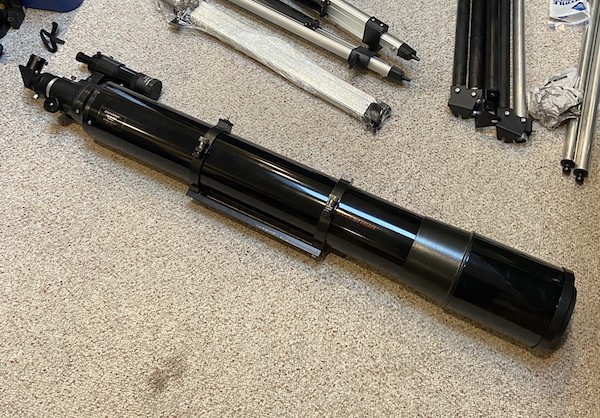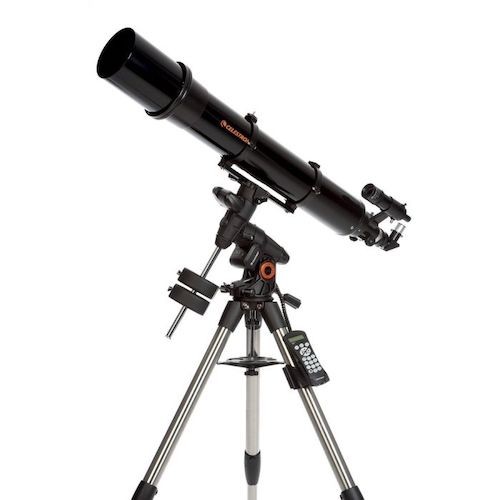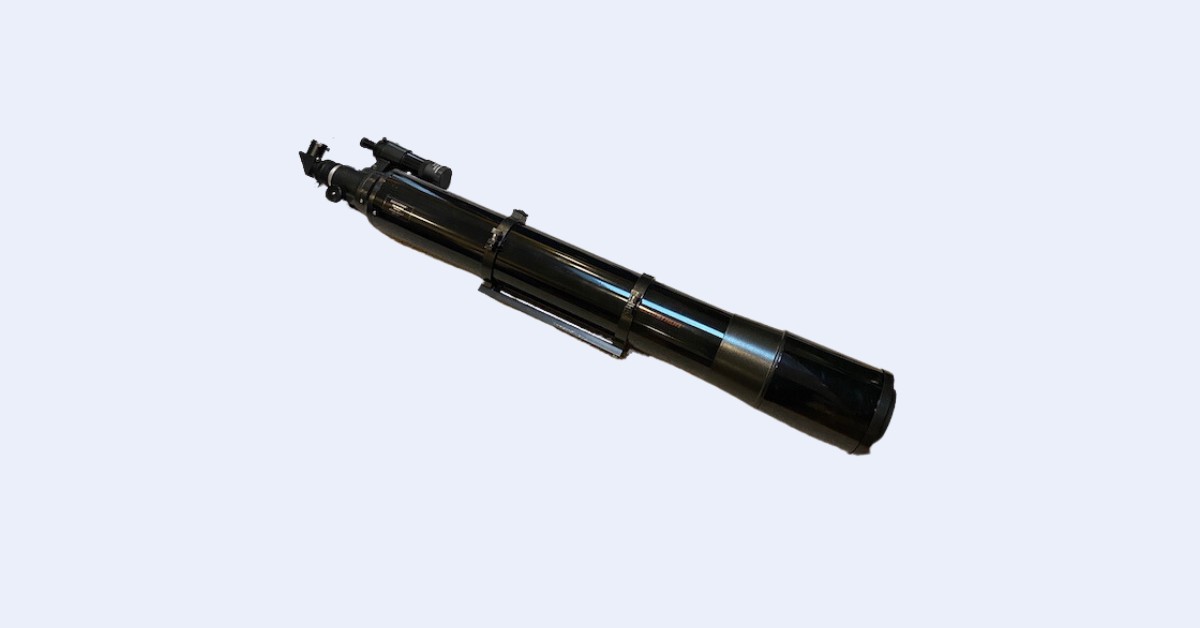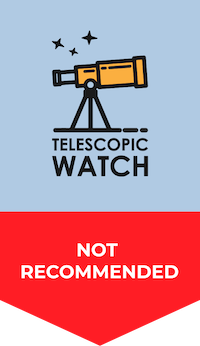The C6R Optical Tube

The Advanced VX 6” Refractor uses the C6R optical tube, a generic 6” (152mm) f/8 achromatic refractor with a 1200mm focal length. To cut down on chromatic aberration, the objective lens of an achromatic refractor is made of two different pieces of glass. Smaller and slow f/ratio achromats can achieve images largely free of significant chromatic aberration, but as aperture increases, chromatic aberration at a given f-stop gets worse. A 4” or 3” f/8 refractor has chromatic aberration that is tolerable on planets, but a 6” f/8 like the C6R has similar amounts of chromatic aberration to something like an 80mm f/5 or a 4” f/6.5. As such, the C6R is not the best for lunar, planetary, or double star work, though it’s still capable of giving nice views of these targets. The lens cell holding the C6R has a metal dew shield attached, and you can actually adjust the lens cell’s push-pull screws for collimation if needed too.
The C6R has a simple 2-inch rack-and-pinion focuser. While all metal and of fairly good construction, there is less ability for fine adjustment compared to a Crayford design, as well as some backlash and slop when making coarse adjustments. The focuser has a built-in shoe for attaching the included 9×50 finder scope. If you want to replace it with an aftermarket Crayford unit, you should look for a focuser with provisions for a new finder shoe or be ready to drill holes into the main optical tube to attach one.
The C6R fits into a pair of adjustable tube rings that are bolted to a Vixen-style dovetail rail. This makes it possible to attach it to a mount. You could replace the Vixen rail with a CGE-style rail if you wish for a slightly stiffer connection to the Advanced VX mount.

Accessories
The Advanced VX 6″ Refractor comes with a single eyepiece: a 25mm, 1.25” E-Lux Plossl that provides 48x magnification. This eyepiece has a 52-degree apparent field of view, giving you a true field of about 1 degree with the C6R. The 25mm E-Lux is fine, but you’ll almost certainly want more eyepieces, such as higher magnifications for planets and 2″ low-power oculars for a wider field.
Celestron provides their standard 1.25” prism star diagonal with the C6R, which works fairly well and yields sharp images. The provided finder scope is a standard 9×50 unit with an upside-down 5-degree true field, arguably overkill for the task of merely aligning the Advanced VX GoTo mount but nice to have regardless (and without the worry of accidentally leaving a switch on and running down a battery).
The Advanced VX Equatorial Mount
I found the Celestron Advanced VX mount to be a solid and reasonably priced GoTo equatorial mount, albeit a little difficult for astrophotographers and overstated in its capabilities. It holds the C6R optical tube well but cannot possibly support a telescope of such a size and focal length for deep-sky astrophotography work. You can swap the C6R for a smaller refractor or Newtonian reflector designed for deep-sky astrophotography. The Advanced VX has some hardware/software issues that tend to be problematic for astrophotography use. It’s far from the best choice as a dedicated imaging-only mount, and other options like the Sky-Watcher HEQ5 Pro may be preferable. Our full review of the Advanced VX goes into more detail on these concerns.
The Advanced VX has a dual Vixen/CGE-style dovetail saddle to hold the C6R’s Vixen-style dovetail rail, though it cannot accept Losmandy-style dovetail plates by default. Two 11 lb counterweights are provided to balance the heavy C6R, with plenty of extra capacity to fit on large eyepieces or other accessories without needing more counterweights. Using the Advanced VX – or indeed any mount – with the C6R will require you to extend the tripod legs all the way to keep the eyepiece end high enough off the ground when pointed near the zenith. Even then, the eyepiece can get quite low, and a pier extension is steadier than extending the legs all the way anyway.
After you set up the tripod and balance the tube by sliding it in its cradle and adjusting your counterweights, you’ll need to polar align the Advanced VX, which requires the purchase of an additional polar alignment scope or attempting to use Celestron’s All-Star Polar Align. With smaller telescopes, you can get away with an imprecise polar alignment by sighting through the empty hole in the VX mount’s polar axis, but the C6R is big enough that a precise polar alignment will save a lot of frustration.
The Advanced VX utilizes Celestron’s NexStar+ hand controller, allowing it to automatically point to and track over 40,000 objects in its database, or you can control it with a SkyPortal WiFi adapter and an app like SkySafari, as well as by plugging the hand controller into your PC with a MicroUSB cable. With a simple 2 or 3-star alignment process after polar alignment, the mount is ready to go. For visual use, the GoTo and tracking capabilities of the mount are more than sufficient, with any inaccuracies likely due to balance, polar alignment, or slight shifts in the tripod legs. The mount can be quickly synced to new alignment stars or whatever it is currently pointed at to improve accuracy throughout the night. You will probably find yourself using this feature a lot; the long tube of the C6R with the eyepiece at the rear means that even slight weight differences between eyepieces noticeably change the balance point and thus torque on the mount, leading to inaccuracies building up over the course of a night.
Should I buy a Used Celestron Advanced VX 6″ Refractor?
A used Advanced VX 6” refractor would have to be considerably discounted from the new price to be worth purchasing. However, if you can find one at a low enough price, there’s not too much to worry about; damage to the objective lens will be obvious if there is any, and you should make sure to get a mount that powers on and functions. Missing accessories can be fairly easily replaced.
Alternative Recommendations
The Advanced VX 6” Refractor is one of my least favorite of all of the available Advanced VX mount and telescope combinations, and there are many other scopes I would consider at similar prices.
Under $1200
- The Apertura AD10/Zhumell Z10/Orion SkyLine 10 is fairly portable, easy to set up, and blows away the Advanced VX 6” Refractor in light gathering or resolving power with an easy-to-use and sturdy Dobsonian mount along with a variety of high-quality included accessories.
- The Explore Scientific 10” Hybrid Dobsonian is extremely compact and offers plenty of light gathering and resolving power, albeit with few features or accessories. The 10” Truss Tube Dobsonian model, also sold by Explore Scientific, is more compact and adds a dual-speed focuser and cooling fans.
- The Celestron NexStar 6SE has similar capabilities to the Advanced VX 6” Refractor apart from a narrower achievable field of view, but has high-quality GoTo and tracking, no chromatic aberration, and is extremely compact too.
- The Sky-Watcher Virtuoso GTi 150P retails for a fraction of the price of the Advanced VX 6” Refractor and is about as compact as the Advanced VX mount head by itself, but offers similar views free of chromatic aberration, with an ultra-compact talbetop Dobsonian mount and collapsible tube, fully motorized GoTo and tracking controlled via your smartphone or tablet, and even the ability to aim the telescope manually while the mount is powered up.
$1200-$1800
- The Apertura AD12/Zhumell Z12/Orion SkyLine 12 offers much greater performance than the Advanced VX 6” Refractor, with quadruple the light-gathering power, double the resolution, and a host of many high-quality accessories provided. It’s similarly heavy and bulky as the Advanced VX 6” Refractor but has fewer parts to assemble and is a lot simpler to use.
- The Sky-Watcher 12″ FlexTube Collapsible Dobsonian blows away the Advanced VX 6” Refractor in capabilities and is surprisingly portable, especially compared to a solid tube 12” design. A full motorized GoTo version is also available.
- The Sky-Watcher 10” FlexTube GoTo Dobsonian is not the most compact or affordable option for a 10” but does feature full motorized tracking and GoTo, controlled via your smartphone or tablet and allowing for easy manual aiming too.
- The Celestron NexStar Evolution 6 is similar to the NexStar 6SE but features the ability to be controlled via your smartphone/tablet along with an integrated battery and better quality components with fewer plastic parts.
$1800+
- The Explore Scientific 12″ Truss Tube Dobsonian is extremely compact, offering lots of light gathering and resolving capability and a solid mechanical design, albeit with a few quirks.
- The Celestron NexStar Evolution 8 offers slightly more resolution and light-collecting power than the 6” model or C6R but is similarly portable to the Evolution 6 and features the same high-quality features and optics.
- The Celestron Advanced VX 9.25” SCT offers sharp views and maxes out the weight capacity of the Advanced VX for visual astronomy, with slightly better performance than an 8” SCT and a considerable improvement over 6” instruments. The 8” Advanced VX SCT combination is great too, but the NexStar Evolution 8 is simpler to operate and easier to transport, and the 9.25” model is worth the step up in price.
Aftermarket Accessory Recommendations
A 2” star diagonal opens up the C6R optical tube to be able to achieve a considerably wider field of view than with 1.25” eyepieces. The Apertura dielectric diagonal is a good choice for this task. The Apertura 38mm SWA (32x) or a similar 35-42mm SWA eyepiece is ideal for a low-power 2” ocular, with the 38mm SWA providing a true field of 1.6 degrees with the C6R. For higher power, cheap “goldline” and “redline” oculars work okay but may add additional chromatic aberration. The Explore Scientific 14mm 82-degree (82x) or Apertura 15mm SWA (80x), Explore Scientific 8.5mm 82-degree (141x), and Explore Scientific 4.5mm 82-degree (267x) would be our top picks for a range of higher magnifications, though other options like the Baader Hyperion series or goldline/redline oculars will work fine as well. The C6R tops out at around 275x magnification, even on a very steady night.
While the importance of filters in astronomy is often overstated, there are two we recommend with the C6R. We’d recommend getting 2” filters, which you can simply screw onto a 2” diagonal and leave there even when swapping eyepieces. A UHC nebula filter like the Orion UltraBlock improves views of objects like the Orion Nebula and brings out previously-invisible ones like the Veil or Flame under dark skies, offering improvements on brighter targets by enhancing contrast even under light-polluted conditions. A minus-violet filter like the Baader Semi-Apo will help reduce the effects of chromatic aberration on the planets and increase contrast at the expense of adding some slight color tint.
As mentioned previously, the C6R requires you to extend the tripod legs of the Advanced VX all the way to put the eyepiece at a comfortable height, and even then it can be on the short side. Unfortunately, nobody sells a pier extension for the mount, so you’d have to make one yourself. Vibration suppression pads will also help with stability; normally we don’t recommend bothering with them, but they make a huge difference with such a top-heavy setup.
For precise and speedy polar alignment, buying the Celestron polar scope for the Advanced VX is almost required for using the Advanced VX. A PoleMaster is also an option should you plan on using the Advanced VX with a different telescope for deep-sky imaging. You’ll also need a power supply of some kind for the mount – either get an AC power cord to plug into a wall outlet or invest in a rechargeable lithium battery. The Celestron PowerTank Lithium, available in standard and higher-capacity Pro versions, simply straps to your tripod and has a fairly long lifetime on account of its advanced battery chemistry. A cheaper unit from TalentCell also works, and you can secure it less elegantly to the tripod with tape, zip ties, or bungee cords.
What can you see?
A 6″ telescope like the C6R is certainly not as powerful as larger reflectors, but its unobstructed design offers comparable views to an 8” Dobsonian on deep-sky objects. You can see dozens of open star clusters with pinpoint colorful stars. With a 2” diagonal and eyepieces, you can fit larger ones like the Pleiades (M45), Beehive (M44) and Double Cluster. Smaller ones like M35 or M11 are great too. Under good seeing conditions, you’ll be able to split the thousands of double stars in the Advanced VX mount’s database. The C6R can resolve individual stars in the biggest and brightest globular clusters, such as M13 or M3, as well. Planetary nebulae begin to show colors and fine detail, such as the Ghost of Jupiter, Blue Snowball, or Blinking Planetary Nebulae.
Larger nebulae, including large planetary nebulae like the Dumbbell and Helix, the huge Veil Nebula supernova remnant, the Crab Nebula, and bright emission nebulae such as Orion (M42), the Lagoon (M8), and the Swan (M17), really look best with dark skies and a UHC nebula filter, with many of these objects losing much of their detail to light-polluted skies or appearing low in contrast unfiltered. However, the brightest targets such as M42 and M8 show up well even under suburban skies with the C6R and will appear truly spectacular under dark skies.
The C6R can also show you many of the brightest and most visible galaxies, provided you are under dark skies. The dust lanes in galaxies like M64, M82, or M104 can be glimpsed along with many galaxy groups and clusters. A few bright spiral galaxies show hints of other details, such as spiral arms, but the C6R lacks the light-gathering ability to use higher power and clearly resolve such details.
Planetary detail with the C6R is limited by the telescope’s aperture and chromatic aberration, but views are still quite nice. The phases of Venus can be seen (though the planet boasts a massive purple halo). Mercury might be hard to resolve clearly. The Moon shows lots of sharp, high-resolution details, however. The chromatic aberration in achromatic refractors affects Mars the worst due to its redness; Mars may show an ice cap or dark markings, but only with considerable difficulty on the best of nights. Jupiter’s cloud belts, the Great Red Spot, and other atmospheric details can be seen, along with its four large moons, which should be resolved as tiny dots along with their shadows during occasional transits in front of Jupiter.
The rings of Saturn and the Cassini Division within them are visible in the C6R, along with a few moons around Saturn and the planet’s dull brown-tan cloud bands. Uranus’ disk is vaguely resolved, though Neptune’s is not easy to distinguish from a star. The C6R may just barely be able to show you Neptune’s moon Triton accompanying the ice giant, but it lacks the light gathering power to reveal Pluto or the moons of Uranus.
Astrophotography Capabilities
The chromatic aberration, inadequacies of the Advanced VX mount, mediocre focuser, and long focal length of the C6R make it a hopeless prospect for any kind of deep-sky imaging. Planetary astrophotography with a suitable camera and 3x Barlow lens can be done, but chromatic aberration is far more problematic photographically than visually, and there are superior telescopes available for the task, including Celestron’s own Schmidt-Cassegrain telescopes sold with the Advanced VX mount.



